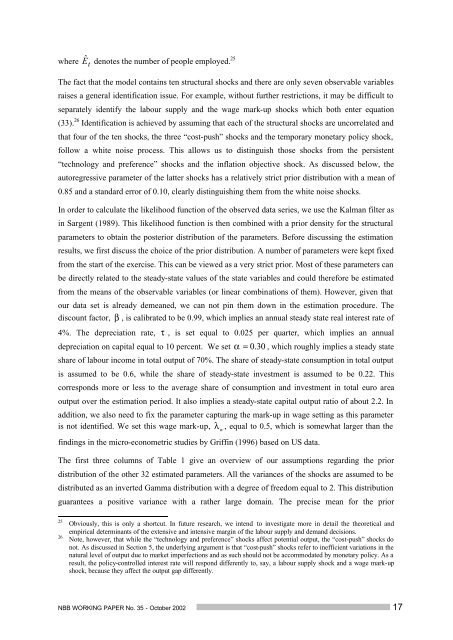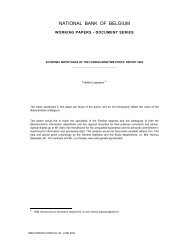An estimated dynamic stochastic general equilibrium model of the ...
An estimated dynamic stochastic general equilibrium model of the ...
An estimated dynamic stochastic general equilibrium model of the ...
You also want an ePaper? Increase the reach of your titles
YUMPU automatically turns print PDFs into web optimized ePapers that Google loves.
whereÊ t denotes <strong>the</strong> number <strong>of</strong> people employed. 25The fact that <strong>the</strong> <strong>model</strong> contains ten structural shocks and <strong>the</strong>re are only seven observable variablesraises a <strong>general</strong> identification issue. For example, without fur<strong>the</strong>r restrictions, it may be difficult toseparately identify <strong>the</strong> labour supply and <strong>the</strong> wage mark-up shocks which both enter equation(33). 26 Identification is achieved by assuming that each <strong>of</strong> <strong>the</strong> structural shocks are uncorrelated andthat four <strong>of</strong> <strong>the</strong> ten shocks, <strong>the</strong> three “cost-push” shocks and <strong>the</strong> temporary monetary policy shock,follow a white noise process. This allows us to distinguish those shocks from <strong>the</strong> persistent“technology and preference” shocks and <strong>the</strong> inflation objective shock. As discussed below, <strong>the</strong>autoregressive parameter <strong>of</strong> <strong>the</strong> latter shocks has a relatively strict prior distribution with a mean <strong>of</strong>0.85 and a standard error <strong>of</strong> 0.10, clearly distinguishing <strong>the</strong>m from <strong>the</strong> white noise shocks.In order to calculate <strong>the</strong> likelihood function <strong>of</strong> <strong>the</strong> observed data series, we use <strong>the</strong> Kalman filter asin Sargent (1989). This likelihood function is <strong>the</strong>n combined with a prior density for <strong>the</strong> structuralparameters to obtain <strong>the</strong> posterior distribution <strong>of</strong> <strong>the</strong> parameters. Before discussing <strong>the</strong> estimationresults, we first discuss <strong>the</strong> choice <strong>of</strong> <strong>the</strong> prior distribution. A number <strong>of</strong> parameters were kept fixedfrom <strong>the</strong> start <strong>of</strong> <strong>the</strong> exercise. This can be viewed as a very strict prior. Most <strong>of</strong> <strong>the</strong>se parameters canbe directly related to <strong>the</strong> steady-state values <strong>of</strong> <strong>the</strong> state variables and could <strong>the</strong>refore be <strong>estimated</strong>from <strong>the</strong> means <strong>of</strong> <strong>the</strong> observable variables (or linear combinations <strong>of</strong> <strong>the</strong>m). However, given thatour data set is already demeaned, we can not pin <strong>the</strong>m down in <strong>the</strong> estimation procedure. Thediscount factor, β , is calibrated to be 0.99, which implies an annual steady state real interest rate <strong>of</strong>4%. The depreciation rate, τ , is set equal to 0.025 per quarter, which implies an annualdepreciation on capital equal to 10 percent. We set α = 0. 30 , which roughly implies a steady stateshare <strong>of</strong> labour income in total output <strong>of</strong> 70%. The share <strong>of</strong> steady-state consumption in total outputis assumed to be 0.6, while <strong>the</strong> share <strong>of</strong> steady-state investment is assumed to be 0.22. Thiscorresponds more or less to <strong>the</strong> average share <strong>of</strong> consumption and investment in total euro areaoutput over <strong>the</strong> estimation period. It also implies a steady-state capital output ratio <strong>of</strong> about 2.2. Inaddition, we also need to fix <strong>the</strong> parameter capturing <strong>the</strong> mark-up in wage setting as this parameteris not identified. We set this wage mark-up, λ , equal to 0.5, which is somewhat larger than <strong>the</strong>findings in <strong>the</strong> micro-econometric studies by Griffin (1996) based on US data.wThe first three columns <strong>of</strong> Table 1 give an overview <strong>of</strong> our assumptions regarding <strong>the</strong> priordistribution <strong>of</strong> <strong>the</strong> o<strong>the</strong>r 32 <strong>estimated</strong> parameters. All <strong>the</strong> variances <strong>of</strong> <strong>the</strong> shocks are assumed to bedistributed as an inverted Gamma distribution with a degree <strong>of</strong> freedom equal to 2. This distributionguarantees a positive variance with a ra<strong>the</strong>r large domain. The precise mean for <strong>the</strong> prior2526Obviously, this is only a shortcut. In future research, we intend to investigate more in detail <strong>the</strong> <strong>the</strong>oretical andempirical determinants <strong>of</strong> <strong>the</strong> extensive and intensive margin <strong>of</strong> <strong>the</strong> labour supply and demand decisions.Note, however, that while <strong>the</strong> “technology and preference” shocks affect potential output, <strong>the</strong> “cost-push” shocks donot. As discussed in Section 5, <strong>the</strong> underlying argument is that “cost-push” shocks refer to inefficient variations in <strong>the</strong>natural level <strong>of</strong> output due to market imperfections and as such should not be accommodated by monetary policy. As aresult, <strong>the</strong> policy-controlled interest rate will respond differently to, say, a labour supply shock and a wage mark-upshock, because <strong>the</strong>y affect <strong>the</strong> output gap differently.NBB WORKING PAPER No. 35 - October 2002 17
















